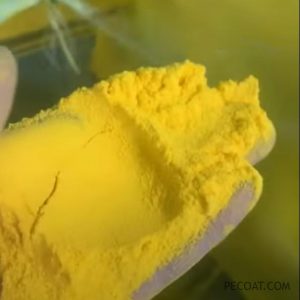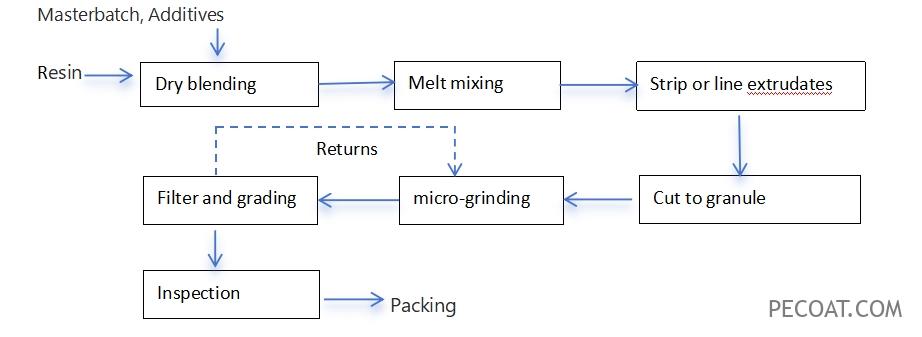High-pressure Polyethylene Powder coatings:Production And Use

1.Introduction
High-pressure polyethylene (LDPE) powder coatings have the characteristics of linear polymer compounds. They can change into a viscous flow state when subjected to high temperatures, and revert to their original resin properties when cooled. At the same time, they possess excellent flexibility, impact resistance, electrical insulation, and chemical corrosion resistance properties. These coatings have a thick layer and are cost-effective. They are suitable for coating everyday household items, traffic barriers, corrosion protection for chemical equipment, automotive parts, etc.
2.Production of high-pressure polyethylene powder coatings
2.1 Production method:
The production method of polyethylene powder coatings adopts an advanced international process of melt blending. In this process, polyethylene pellets and pigment granules are first mixed in a high-speed mixer, and then the thoroughly mixed materials are melted, blended, and extruded through a designed extruder. The extruded material is cooled in a water-cooling tank, cut into granules, ground into fine powder in a pulverizer, and then sieved to obtain polyethylene powder coatings with the desired particle size, which are the final product.
This method has the following advantages:
- 1) Resin and pigments (including resin, pigments, fillers, and additives) are melted and extruded through a designed screw length-to-diameter ratio, speed, and thread block in the extruder, resulting in even dispersion of materials, good blending effects, and improved weather resistance, mechanical properties, and surface gloss of the coatings;
- 2) The entire process is simple, with low labor intensity, good environmental hygiene, and the capability to achieve continuous production in various scales.
2.2 Process Flow Diagram:

2.3 Process Formulation and Operations:
2.3.1 Materials and Formulation (see Table 1)

2.3.2 Operations
- 1) Pour the measured 1150A, color masterbatch, and additives into the mixer and mix for about 30 minutes.
- 2) Add the mixed material to the hopper of the extruder.
- 3) Set the heating temperature of the extruder as follows: Section 1 – 160℃, Section 2 – 150℃, Section 3 – 160℃, Section 4 – 170℃.
- 4) Draw the material into filaments and granulate it through a mill to achieve a particle size of 0.25mm (60 mesh, residue <5%) to obtain the finished product.
3. Characteristics of High-pressure Polyethylene Powder Coating
The advantages of high-pressure polyethylene powder coating are as follows:
- Strong anti-corrosion performance, with good corrosion resistance to various chemical media and high resistance to acid rain, oxidation, etc. in the atmosphere.
- Excellent weather resistance. Many guardrails coated with oil paint show serious corrosion and aging after 1-2 years, while the weather resistance of polyethylene powder coating is superior, and it will not age and lose color even after long-term use, with a service life of more than 15 years.
- Excellent decorative effect. Polyethylene powder coating has vibrant and full colors, good texture, and excellent decorative effect.
- No pollution. The use of paint and galvanizing contains
The main technical specifications of high-density polyethylene powder coatings products:

4. Coating Process
The coating process of high-pressure polyethylene powder coating is different from traditional paint coating and does not cause pollution to the air and surrounding environment. The coating raw materials will not be wasted and can be recycled for reuse. It is less likely to cause accidents such as fires, and the main coating process is as follows.
- Thermal coating process : fluidized bed dipping, Flame spraying, Thermal spraying,Rotate coating process.
- Cold coating process:Electrostatic spraying,Electrostatic vibration,Spray glue cold coating method
A schematic diagram of the traditional fluidized bed process is shown as follows.
Workpiece → preheat → fluidized bed dipping → post heat for curing → cooling → quality testing → packing
The coating of high-pressure polyethylene powder coating can be done using a conveyor system or an intermittent system. The conveyor system requires a larger investment but has a higher production volume and efficiency. The intermittent system is suitable for small-batch production. The main equipment and process parameters are listed in Tables 3, 4, and 5.

Table 4 – Coating process parameter:
- Preheat temperature: 350 ℃, 8-10 minutes
- Dipping process: 300±10 ℃, 0.08-0.17 minutes
- Post heat temperature: 240±10 ℃, 3-5 minutes
- Cooling: water cooling or air cooling
Technical Specifications for Coating layer:
| No. | Items | Index value |
| 1 | Appearance | Smooth colorful |
| 2 | Thickness | 0.5-1.0mm |
| 3 | Adhesion | 1 level |
| 4 | Bending | 1 mm |
| 5 | Anti-impact | 21.6 J |
| 6 | Brittleness temperature | ≤ -65℃ |
| 7 | Tensile strength | ≥12 Mpa |
| 8 | Elongation at break | ≥500% |
| 9 | Weather ability | 1200hours, no change |
| 10 | Alkali resistant(10% NaOH), acid resistant(10% HCI) and salt resistant(10% NaCI)
160hours, 23±2℃ |
Tensile elongation and tensile strength retention≥80% |
5. Application of High-pressure Polyethylene Powder Coatings
At present, polyethylene powder coatings are mainly used for the coating of highway, railway isolation fences, municipal construction guardrails, traffic guardrails, public venue tables and chairs, bicycle baskets, daily shoes, hats, and clothes racks, chemical equipment corrosion protection, etc. In the future, it can also be promoted for the purpose of water pipe corrosion protection and food hygiene packaging. Due to the high weather resistance, strong corrosion resistance, excellent decorative properties, and green environmental protection features of polyethylene powder coatings, it is believed that there will be a better application prospect.
